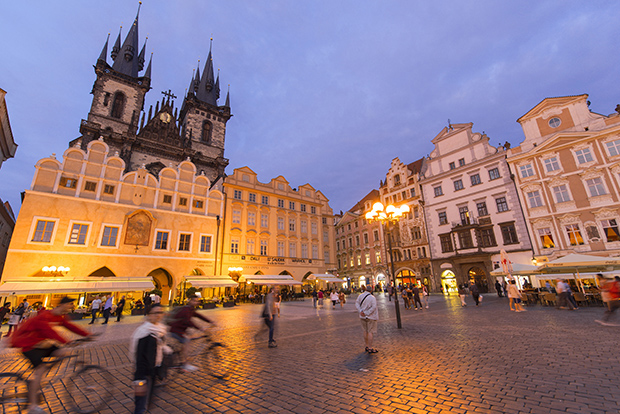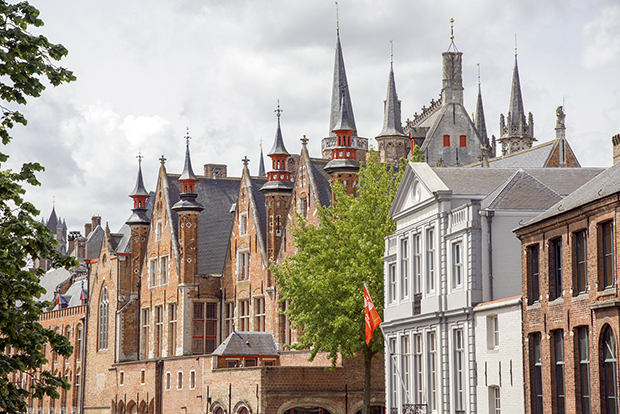Is it time to trade your kit zoom lens in on something faster? As Peter Burian explains, the extra cost might take some getting used to, but there are benefits to be had in terms of image quality and low-light performance.
Because most digital SLR camera owners demand compact, lightweight lenses, most zooms feature a small maximum aperture. That applies to telephoto zooms as well. A typical zoom lens is designated as f/3.5-5.6 or f/4-5.6, indicating the maximum aperture is quite small at the short end and becomes very small at longer focal lengths. In practical terms, that translates to a moderate light gathering ability. On the other hand, some lenses boast a much wider maximum aperture of f/2.8 – available at all focal lengths – which offer significant benefits that I’ll discuss later.
For a stock photography trip I recently did through Europe with a full-frame Nikon D800, I took three f/2.8 lenses – an ultra-wide 15-30mm, a “normal” 24-70mm zoom and a 70-200mm telephoto. These were Tamron models, but you can find ultra wide, normal and telephoto f/2.8 in several other brands. They’re available for DSLRs with a full-frame or smaller sensor and also for mirrorless cameras. A few zooms offer an even wider maximum aperture, such as the Sigma 24-35mm f/2 DG HSM for DSLRs. Since f/2.8 is a far more common maximum aperture, let’s take a look at the many advantages of this type of so-called "fast" zoom lens.

One of Nikon's most popular fast lenses, the Nikon AF-S 70-200mm f2.8G ED VR II.
Low-light benefits
Serious shooters appreciate f/2.8 telephotos because they allow you to shoot at faster shutter speeds. Granted, this may not be an issue on bright, sunny days even at f/5.6 when using ISO 200, for example. In much darker locations, however, a very wide aperture can be a blessing. Let’s say you’re shooting a sports event in an indoor arena. If a lens’ widest aperture is f/5.6, you might need to use ISO 6400 to freeze the competitors’ motion. Switch to a 70-200mm f/2.8 zoom and you could achieve the same action-stopping effect at ISO 1600.
Note, too, that the wide maximum aperture is constant with nearly all “fast” zooms; it’s available at all focal lengths. This is a definite benefit against the more typical zooms whose maximum aperture becomes smaller as you shift to longer focal lengths. With a constant f/2.8 aperture, the exposure time will not become longer as you zoom from 70mm to 200mm (to compensate for the increasingly smaller aperture) for example. An image made at a lower ISO level will exhibit less digital noise: the “grainy” pattern of random, coloured specks that can obliterate intricate detail. While Noise Reduction processing (in the camera or in a computer) can provide smoother high ISO images, the effect is achieved by blurring the “grain” pattern. But this also smudges fine detail, reducing resolution. On the other hand, a low ISO image be “cleaner” – with less obvious coloured speckles – and more richly detailed.
Recently I was shooting street scenes, cultural events and architecture in Europe, and I found the wide aperture was most useful for a shutter speed that would minimise blurring from camera shake. A tripod would have been ideal, but that accessory is prohibited in locations such as St. Stephan (a cathedral) and Schönbrunn (a palace) in Vienna, Austria. It was also impractical to use a tripod on a busy urban street. In dark locations ISO 1600 often allowed for a 1/60s shutter speed at f/2.8. At the long end of a 24-70mm lens, this minimised blurring from both camera shake and from the movement of people in the scene. With a lens that offers a smaller maximum aperture of f/5.6, ISO 6400 would have been required for shooting at 1/60s.
I walked for eight to ten hours a day without a tripod. I relied upon my lenses’ wide f/2.8 apertures to minimise the risk of blur from camera shake. This allowed me to shoot at adequate shutter speeds to get sharp images. Nikon D800, 15-30mm, 1/10s @ f/2.8, ISO 320; vignette correction in software.
Optical & build quality
Because many wide aperture lenses are prosumer or professional grade products, they usually feature high-grade optical elements for better image quality. This applies to the many of the constant f/2.8 aperture models. They use at least several large pieces of low-dispersion glass and/or aspherical glass for optimal image quality, even at f/2.8. The high-tech elements are designed to correct optical aberrations for high sharpness at f/2.8 and also to minimise distortion. An increasing number of inexpensive zooms also use high-tech elements, but typically, only one or two pieces of a small size. But most f/2.8 zooms use more such elements, of larger diameter, and often with superior types of glass. For example, the Canon EF 70-200mm f/2.8 L IS II USM zoom includes a very expensive fluorite element plus five pieces of ultra-low dispersion glass. And the Nikon AF-S 17-35mm f/2.8G ED model is made with two large extra-low dispersion elements plus three aspherical elements made of ground glass (not plastics). Both provide stunning image quality across the frame, even at f/2.8, at all focal lengths.
With the lenses I carried, f/2.8 was often useful for recording the vast, dark interiors of Gothic churches. My images exhibit outstanding sharpness, even at the edges of the frame. Darkening at the corners (light fall off or vignetting) is quite common with most zoom lenses of most brands, particularly at wide apertures. Fortunately, that’s easy to fix with imaging software which includes a vignette correction utility. Moderate size and weight are important attributes in mass-market zooms, but the f/2.8 models have superior construction and mechanisms. Hence they tend to be more rugged. Some are even weather and dust resistant, including the lenses that I used with a DSLR that’s also well-sealed against the elements. This aspect was ideal during rainy evenings while shooting in the historic quarters of Prague and Amsterdam.
Compared to kit lenses, high-grade f/2.8 lenses often deliver beter sharpness towards the edges of the images.
Focus & depth of field
A fast lens transmits a great deal of light to the camera’s viewfinder and the autofocus sensor, making it easier to focus in low light. Manual focusing is less problematic than it would be with a small aperture lens because the view is brighter. That can be very useful when shooting inside a dark home, a theatre, a cathedral or a castle. Autofocus is quicker and more reliable in dark locations as well. It can make AF possible in situations where the camera would baulk if you were using a more typical f/4-5.6 zoom. With the f/2.8 lenses I was using, autofocus was always successful, even in very dark areas of the Oude Kerk (church) in Delft, Netherlands.
There’s another benefit to using an f/2.8 lens especially at focal lengths of 135mm or longer: the depth of field is shallower at the wider aperture. The narrower range of acceptably sharp can be useful. It allows for keeping a nearby subject sharp while defocusing a cluttered background, throwing it all into a wash of colours. The effect is most obvious when the subject is no more than two metres from the camera. When it’s sharply framed against a soft backdrop, the centre of interest immediately attracts and holds the viewer’s attention.
Note: Do not interpret a “defocused” foreground or background as a sign of poor optical performance at f/2.8 at telephoto focal lengths. It’s caused by the shallow depth of field at f/2.8. That aspect also makes it essential to focus carefully on the most important subject element, such as the eyes – instead of the tip of the nose – in a portrait photo. With an ultra wide-angle lens however, it’s easy to make images with extensive depth of field at a very wide aperture.
While the more portable f/4-5.6 (or similar) zoom lenses are cheaper and lighter, the f/2.8 and f/4 constant-aperture models deliver sharper images and offer better performance in low light. Nikon D800, 70-200mm f/2.8 lens.
The bottom line
As I’ve already hinted, the wide-aperture zooms aren’t ideal in every respect. They’re large, and hence heavy, because of the oversized diaphragm needed to accommodate an aperture of f/2.8. Rugged construction, with metal components, also increases the weight. Because of the greater amount of materials – especially for the large optical elements – they’re also more expensive. Hence, the f/2.8 lenses aren’t as portable or as affordable as their more easily carried f/4.5-5.6 or similar counterparts. Making up for the drawbacks, a fast, constant aperture zoom provides the benefits already discussed. Most important for my needs was the image quality ranging from excellent to superlative. In fact, some of my best images from Europe made for A1 size (594 x 841mm) custom prints which look stunning on the walls of my home. Visit a photo retailer to check out some fast zooms. Take a few shots indoors and note that the shutter speed is adequately fast at f/2.8 without a very high ISO level. This hands-on experience will also establish whether you’ll be comfortable with a hefty lens, especially a 70-200mm model which can weigh between 1 and 1.5 kg. While I appreciate the benefits of great portability, the three f/2.8 zooms I used were ideal for making images which would satisfy even discriminating photo buyers. Of course, you need not be shooting professionally to appreciate the advantages of a fast zoom with high-grade optics and construction. If you’re an experienced shooter, or a budding enthusiast who is ready to produce superior potential quality, you may be a candidate for at least one such lens. Though not inexpensive, this category of lens will provide great value, paying dividends with features and technology that complement your creative vision.
Peter Burian is the author of several books including Mastering Digital Photography and Imaging as well as guide books to many enthusiast-level cameras and their accessories.
The three f/2.8 lenses I was using in Europe, like most zooms in this category, were of pro calibre, producing images with exceptional colour rendition, contrast and resolution. Particularly at f/5.6 or f/8, edge sharpness equalled central sharpness, with impressive resolution of intricate detail. Nikon D800, 70-200mm f/2.8 lens.










